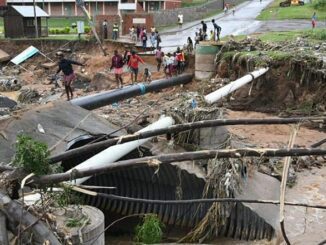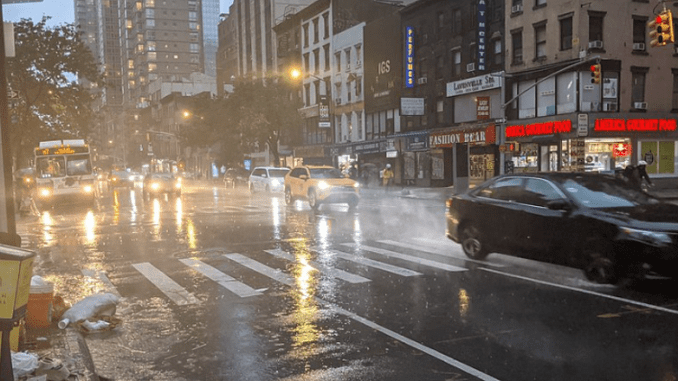
NEW YORK, New York, July 8, 2022 (ENS) – New York City Mayor Eric Adams and staff Thursday released the Rainfall Ready NYC action plan – a plan to prepare the city government and all New Yorkers for a future of more extreme rainfall. As climate change brings more extreme weather to the five boroughs, the city is making investments in infrastructure to keep New Yorkers safe, but in the short-term the city of eight million people needs to be ready for trouble.
Since September 2010, New York has experienced weather disasters: severe storms, tornadoes, floods, tropical storms, snow and ice storms. Just 10 months ago, Hurricane Ida’s sudden heavy rainfall killed a dozen New Yorkers. Eleven of those people, police officials said, were in basements when they died.
“Climate change is the city’s biggest environmental threat, and while we continue to invest in resiliency and infrastructure projects to protect us for generations to come, the Rainfall Ready NYC action plan will help every New Yorker to protect themselves, their families, and their homes,” said Mayor Adams, announcing the plan on Thursday.
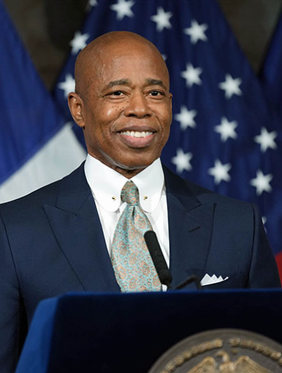
“The city is acting now to keep New Yorkers safe as we move into hurricane season, and I encourage every New Yorker to make emergency plans for the next extreme weather event,” Mayor Adams said.
The new action plan outlines new steps New Yorkers can take to protect themselves and their property, say city officials, led by New York City Chief Climate Officer and Department of Environmental Protection Commissioner Rohit Aggarwala.
“Our climate is changing and that means increasingly common extreme weather impacting New York City, but there are measures we can take to prepare ourselves and the Rainfall Ready NYC action plan outlines the projects city government has underway to manage our new reality, as well as steps residents can take to protect themselves and their property,” said Aggarwala.
“The design and construction of large infrastructure projects to manage our changing climate will take time to complete and Rainfall Ready NYC is meant to outline the shared actions that can be taken in the short-term to ensure public safety,” he explained.
“Every New Yorker deserves to live in a safe home in the face of a changing climate,” said New York City Chief Housing Officer Jessica Katz. “Working with Chief Climate Officer Aggarwala, we will ensure that New York City is prepared for increasing extreme weather and that our neighbors’ homes are protected against flooding. Rainfall Ready is an important step forward in building stronger housing and a more resilient city.”
New York City Emergency Management Commissioner Zach Iscol sees the value of preparing now for future flooding rains. “Being prepared for extreme weather emergencies is a shared responsibility, and Rainfall Ready NYC is a blueprint that will guide us throughout all phases of the disaster cycle,” said Commissioner Iscol.
“While the city has made several improvements to its operations – from mitigation to preparedness, response, and recovery – Rainfall Ready NYC captures how we will continue to safeguard our city and the public. With hurricane season and summer under way,” said Iscol, “I also encourage New Yorkers to make emergency plans that best match their needs before extreme weather and other emergencies occur, by visiting us online or calling 311.”
As rising greenhouse gas emissions accelerate climate change, New Yorkers should expect more frequent and extreme rainfall events that can produce volumes of stormwater that the city’s infrastructure was never designed to capture.
While the city is making investments to improve resiliency and prepare New York City for the effects of climate change, all New Yorkers can take immediate steps to prevent death, injury, and property damage when these intense rainfall events do occur.
Rainfall Ready NYC outlines what steps New Yorkers and city government can take to combat extreme weather together, including:
- – Encouraging New Yorkers to use new interactive stormwater flood maps to understand the likelihood of flooding on one’s block and to make a plan to get to higher ground if needed.
- – Inspecting chronic flooding locations and clearing debris from catch basins in at-risk locations prior to predicted storms. New Yorkers are encouraged to clear litter and debris from the curb line and nearby catch basins and deploy barriers to protect low-lying areas.
- – Expanding FloodNet, a network of street flooding sensors designed to better understand the frequency, severity, and impacts of flooding in New York City. These sensors will be installed in the most vulnerable areas for real-time data collection and will be accessible via a dashboard for public use beginning later this month.
- – DEP will also be providing sandbags and flood barriers to residents in at-risk neighborhoods, and the city has engaged Los Deliveristas, Uber Eats, GrubHub, and DoorDash in a working group to create new strategies for ensuring extreme weather messaging reaches delivery workers. The group will also work to develop protocols to ensure that delivery workers are kept safe during extreme weather, such as restricting deliveries during dangerous weather conditions.
“As somebody who grew up in South Beach, we know full well that Staten Island has too often seen extreme flooding impact neighborhoods, homes, and lives caused by rainfall during heavy storms,” said Staten Island Borough President Vito Fossella. “Fortunately, there has been much progress over the last 40 years, but we still need to do more. After remnants of Hurricane Ida hit New York City in September, many families who historically have never seen flooding in their communities, were directly impacted. Extreme rainfall has been a dangerous problem for the borough and will continue to be a public safety issue without the proper action.”
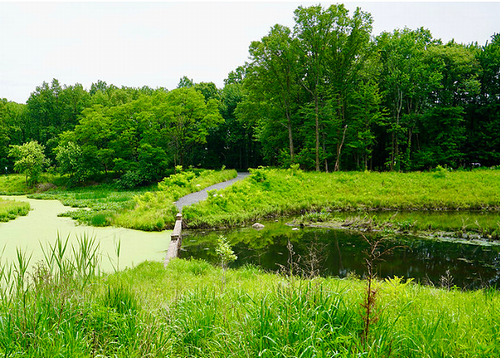
The plan also calls attention to the importance of the Bluebelt system. More than a dozen Bluebelts on Staten Island alone use natural spaces such as ponds and creeks to divert stormwater away from flooding that could invade homes.
“These tried and true measures prove it is often best to work with nature, and not against it,” said Fossella. “Additionally, keeping our catch basins and sewer grates clean of litter, especially ahead of a storm, will help to mitigate the flooding that Staten Island often sees during and after a big storm.”
New York City Council Member James Gennaro, who chairs the Committee on Environmental Protection, said, “Climate change is one of the biggest threats facing our city. New York City has over 7,500 miles of sewers that are designed to capture rainfall from a five-year storm, which is a rain event that has a 20 percent chance of occurring in any given year.”
“It is crucial that we invest in the appropriate infrastructure and prepare New Yorkers, especially as extreme weather events become more common,” Gennaro said, calling the Rainfall Ready NYC action plan a “much-needed resource.”
Food Delivery Workers Like New Action Plan
When the weather hits extreme, the whole city relies on its food delivery workers.
Hildalyn Colon Hernandez, director of policy and strategic partnerships, Los Deliveristas Unidos/Workers Justice Project, deals with extreme weather situations now more than ever, due to climate change.
“Deliveristas work under rain, shine, or snow. Los Deliveristas Unidos/WJP sees closely and personally how climate change impacts the job and workers’ safety across New York City,” Hernandez said.
“As the city put a plan to develop the infrastructure to deal with the impacts of climate change and we need bigger efforts to prepare and protect the people and the worker force, such as Deliveristas, that make the city move,” she said.
“The Rainfall Ready NYC action plan is an urgent call to the climate crisis we all live in. This plan shows how working people, such as Deliveristas, can be part of the change and propose solutions to protect and care for our planet,” offered Hernandez.
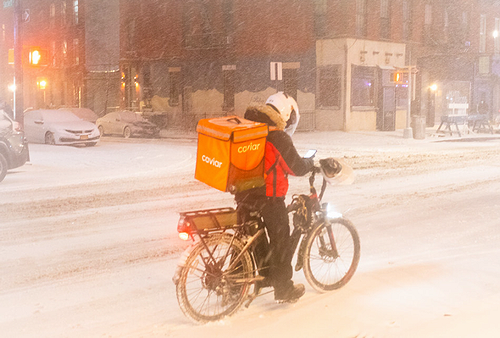
“It is critical to our mission that those who deliver on our platform can do so safely,” said Freddi Goldstein, communications manager, Uber Technologies. “We are looking forward to working with Mayor Adams, the DEP and NYCEM to do all we can to keep couriers safe when extreme weather is in the forecast.”
“We welcome Rainfall Ready NYC and commend Mayor Adams for launching this important and necessary initiative,” said Sascha Owen, senior manager of government relations, DoorDash. “Rainfall Ready NYC recognizes that everyone – from companies to community groups and governments – has an important role to play in helping keep all New Yorkers safe. The safety of delivery workers and the communities we serve is core to everything that we do, and we will continue to work closely with policymakers and share the lessons we’ve learned from developing our robust emergency response protocols.”
“Every day, Grubhub works with tens of thousands of delivery partners and restaurants across the five boroughs, and their safety is absolutely our highest priority,” said Joshua Bocian, senior manager for government affairs, Grubhub. “We continue to use our in-app messaging system to communicate ahead of and throughout extreme weather events, and we look forward to working closely with the city on innovations to best protect each and every one of our delivery workers.”
“New Yorkers are already feeling the impacts of a changing climate and increased rainfall, and these impacts are not felt equally,” said Executive Director of the Mayor’s Office of Climate and Environmental Justice Kizzy Charles-Guzman.
“Initiatives like Floodnet provide the real-time, hyperlocal flood information that we need to take immediate street-level action like road closures, travel bans, or informing residents on the need to deploy sandbags and flood barriers, as well as help us to target our efforts in the most vulnerable communities, validate existing flood models, and provide data for future drainage investments,” she said.
“As the City continues to invest in longer-term projects to address these hazards,” Charles-Guzman said, “Rainfall Ready NYC is a crucial resource for residents and City government to take action now towards shared stormwater resiliency.”
The Rainfall Ready NYC action plan will be shared widely in the weeks and months to come as all New Yorkers take steps to prepare for more extreme weather.
Featured image: Hurricane Ida dumps rain on Manhattan’s Sixth Avenue at 29th Street. September 1, 2021 (Photo by Eden, Janine and Jim)
© 2022, Environment News Service. All rights reserved. Content may be quoted only with proper attribution and a direct link to the original article. Full reproduction is prohibited.

